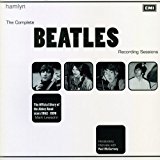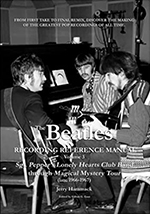Thursday, March 9, 1967
Recording "Getting Better"
For The Beatles
Last updated on December 31, 2023
Thursday, March 9, 1967
For The Beatles
Last updated on December 31, 2023
Recording "Sgt. Pepper's Lonely Hearts Club Band"
Nov 24, 1966 - Apr 20, 1967 • Songs recorded during this session appear on Sgt. Pepper's Lonely Hearts Club Band (UK Mono)
Recording studio: EMI Studios, Studio Two, Abbey Road • London • UK
Session Mar 07, 1967 • Recording "Lovely Rita"
Interview Mar 07, 1967 • Paul McCartney interview for Granada Television
Session Mar 09, 1967 • Recording "Getting Better"
Session Mar 10, 1967 • Recording "Getting Better"
Session Mar 13, 1967 • Recording "Good Morning Good Morning"
AlbumSome of the songs worked on during this session were first released on the "Sgt. Pepper's Lonely Hearts Club Band (UK Mono)" LP
On this day, The Beatles began recording Paul McCartney’s “Getting Better.” Engineers Geoff Emerick and Richard Lush had the night off and were replaced by Malcolm Addey and Ken Townsend, assisted by Graham Kirkby. Despite the studio being booked for 7 pm, The Beatles did not arrive until after midnight, as recalled by Malcolm Addey.
During the session, The Beatles recorded seven takes of the rhythm track for the song. Take 1 was later released in the 2017 “Sgt. Pepper’s Lonely Hearts Club Band” box set.
According to Jerry Hammack’s book “The Beatles Recording Reference Manual: Volume 3: Sgt. Pepper’s Lonely Hearts Club Band through Magical Mystery Tour (late 1966-1967)“ and Kevin Howlett’s notes in the 2017 “Sgt. Pepper’s Lonely Hearts Club Band” box set, Paul McCartney played a Pianet electric piano, John Lennon and George Harrison played electric guitars, and Ringo Starr played the drums. However, George Martin recalled playing the Pianet electric piano, “hitting the strings of this thing, rather than the keys, looking for ways to vary the sound.” It is possible that the players changed between Take 1 and Take 7.
As each of the four instruments was recorded on a different track of the four-track tape, a reduction mix was necessary. Five attempts were made, labelled Takes 8 to 12, to reduce the four tracks to one. Take 12 was selected as the best and overdubs were added the next day. The session ended at 3:30 am.
Geoff [Emerick] had been doing a lot of late-night work and was getting very tired. I remember the session was booked to begin at 7pm but there was barely a Beatle in sight before midnight, and we were sitting around waiting. They eventually straggled in one by one. Ringo came in about 11 and ordered fish and chips. The others arrived later, they all hung around and finally started work at about one in the morning. The ego trip of the big-time artists had started to set in... I know their method of working upset Geoff from time to time
Malcolm Addey – From “The Complete Beatles Recording Sessions” by Mark Lewisohn, 1988
On Thursday 9 March our usual engineers Geoff Emerick and Richard Lush had a night off, to give them a bit of a break. Malcolm Addy was brought in, along with Ken Townsend. […] Malcolm remembers that the session was arranged for the normal 7 p.m. start time. Nobody turned up — in fact there were very few Beatles to be seen before midnight. Ringo strolled in some time after eleven, and immediately ordered fish and chips. The others turned up later still.
They were beginning to take the people at Abbey Road a bit for granted. Maybe Paul had been polishing up his song — but he wasn’t even the last to arrive. Work didn’t get under way until about one in the morning — after John had arrived. I didn’t ask where he’d been.
We spent two nights laying down the basic rhythm track, a very stringy sound with a relentless driving rhythm. I played a pianette, an early kind of electric piano, which gave us a funny kind of plucking sound, a cross between a harpsichord and a Fender Rhodes electric piano. The modern equivalent would be the cheapest Casio electric keyboard, only the Casio is about twenty times more sophisticated than the pianette. I made noises hitting the strings of this thing, rather than the keys, looking for ways to vary the sound. […]
George Martin – From “With A Little Help From My Friends: The Making of Sgt. Pepper“, 1995
John was late for the session. Paul was at the piano demonstrating to me what the song was going to sound like. At the moment he sang, ‘I’ve got to admit it’s getting better, getting better all the time,’ John came through the door and actually sang, ‘It can’t get no worse.’
George Martin – From “The Beatles: Off the Record” by Keith Badman, 2008
Malcolm Addey – he of the cigar and never-ending chatter – filled in for me that evening… Ken Townsend was recruited to substitute for Richard [Lush]. Ken was really a maintenance engineer, but I suppose George [Martin] just wanted a familiar face around, someone whom the group had at least met before.
I suspected that the four Beatles were annoyed that I wasn’t there – there was no way they wanted a stranger engineering their sessions – and the next night, when I returned, my suspicions were confirmed.
“Glad to have you back, Geoff,” George Harrison said as soon as he walked in the door. Malcolm had clearly gotten on his nerves.
When we played back the tapes of the previous evening’s work in the control room, Ringo chimed in. “The drums sound a bit naff, don’t you think?”
George Harrison didn’t even wait for an answer. “Little wonder, considering that Malcolm didn’t shut up long enough to get a decent drum sound.”
Geoff Emerick – From “Here, There and Everywhere: My Life Recording the Music of The Beatles“, 2006
On “Getting Better” there’s a large number of engineers credited [on the 1987 CD release]: Malcolm Addey, Ken Townsend, Geoff Emerick, Peter Vince, Graham Kirkby, Richard Lush, and Keith Slaughter. Why was that, George?
George Martin: I’m surprised at that. I can’t think what Ken is doing there.
Ken Townshend: I’m credited on that because Malcolm Addey used to go home at midnight. So somebody took over—I took over to carry on to 3 or 4 in the morning on two or three occasions. The number of engineers credited is because it was done over several sessions on several nights. Sometimes if the regular guy is away a bit of a stopgap goes on. But Malcolm Addey, at midnight he’d say, Right, I’m going home now. And so when I was technical engineer, once or twice I took over from him.
1987 interview – From Recording Sgt. Pepper’s: Unpublished Conversations with | Reverb News
This was the first recording session at which Beatles biographer Hunter Davies was present, so he reveals in his book how the group learned and arranged the song from the ground up.
The next evening, Paul and John went to the recording studio. Paul played the new song on the piano, la-la-ing the accompaniment or banging in tune to his words, to give the others an idea of what it sounded like. Ringo and George said they liked it; as did George Martin.
The first stage in the layer cake system that they now use in recording songs was to get the backing recorded on one track.
They discussed what the general sound would be like and what sort of instruments to use. They also chatted about other things. When they got bored, they went off and played on their own on any instruments lying around. There was an electronic piano in the corner of the studio, left over from someone else’s recording session. Someone doodled on it and it was decided to use it.
Ringo sat at his drums and played what he thought would be a good drum backing, with Paul singing the song to him in his ear. Because of the noise, Paul had to shout in Ringo’s ear as he explained everything.
After about two hours of trying out little bits and pieces, they had the elements of a backing. George Martin and two studio technicians, who’d been sitting around just waiting up until then, went up into their sound-proof glass control room, where they continued to sit around and wait for the Beatles to get themselves organized.
Neil and Mal got the instruments and microphones arranged in one corner of the studio and the four of them at last started to sing and play, ‘It’s Getting Better’. Ringo looked a bit lost, sitting slightly apart on his own, surrounded by his drums. The other three had their heads together over one microphone.
They played the song over about ten times. All that was being recorded, up in the sound-proof box, were the instruments, not their voices. From time to time, Paul said ‘Once more, let’s try it this way,’ or ‘Let’s have less bass, or more drums.’ By midnight they had recorded the backing.
From “The Beatles: The Authorised Biography” by Hunter Davies, 1968
Recording • Take 1
AlbumOfficially released on Sgt. Pepper's Lonely Hearts Club Band (50th anniversary boxset)
Recording • Take 2
Recording • Take 3
Recording • Take 4
Recording • Take 5
Recording • Take 6
Recording • Take 7
Tape copying • Tape reduction take 7 into take 8
Tape copying • Tape reduction take 7 into take 9
Tape copying • Tape reduction take 7 into take 10
Tape copying • Tape reduction take 7 into take 11
Tape copying • Tape reduction take 7 into take 12
The Complete Beatles Recording Sessions • Mark Lewisohn

The definitive guide for every Beatles recording sessions from 1962 to 1970. We owe a lot to Mark Lewisohn for the creation of those session pages, but you really have to buy this book to get all the details - the number of takes for each song, who contributed what, a description of the context and how each session went, various photographies... And an introductory interview with Paul McCartney!
The Beatles Recording Reference Manual: Volume 3: Sgt. Pepper's Lonely Hearts Club Band through Magical Mystery Tour (late 1966-1967)

The third book of this critically - acclaimed series, nominated for the 2019 Association for Recorded Sound Collections (ARSC) award for Excellence In Historical Recorded Sound, "The Beatles Recording Reference Manual: Volume 3: Sgt. Pepper's Lonely Hearts Club Band through Magical Mystery Tour (late 1966-1967)" captures the band's most innovative era in its entirety. From the first take to the final remix, discover the making of the greatest recordings of all time. Through extensive, fully-documented research, these books fill an important gap left by all other Beatles books published to date and provide a unique view into the recordings of the world's most successful pop music act.
If we modestly consider the Paul McCartney Project to be the premier online resource for all things Paul McCartney, it is undeniable that The Beatles Bible stands as the definitive online site dedicated to the Beatles. While there is some overlap in content between the two sites, they differ significantly in their approach.

Notice any inaccuracies on this page? Have additional insights or ideas for new content? Or just want to share your thoughts? We value your feedback! Please use the form below to get in touch with us.